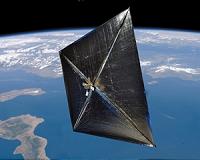 |
Hawthorne CA (SPX) Aug 23, 2010 SpaceX has announced their Dragon spacecraft has successfully completed a high altitude drop test - meeting 100% of test objectives. This is the last in a series of tests to validate parachute deployment systems and recovery operations before the craft's first launch. During the August 12th test, an Erikson S-64F Air-Crane helicopter dropped a test article of the Dragon spacecraft from a height of 14,000 feet, roughly nine miles off the coast of Morro Bay, California. In a carefully timed sequence of events, dual redundant drogue parachutes deployed first to stabilize and gently slow the craft before three main parachutes, 116 feet in diameter, further slowed the craft to a picture perfect landing. From there, recovery ships successfully returned the Dragon and parachutes to shore. While Dragon will initially be used to transport cargo, the spacecraft was designed to transport crew and the parachute system validated during the test is the same system that would be used on a crew-carrying Dragon. "By holding the Dragon to stringent standards for manned missions from the start, tests like this will ensure the highest quality and reliability for Dragon over the long term," said Elon Musk, SpaceX CEO and CTO. "We are proving, every day, that the future of American missions to space will rely on American made commercial companies." The two drogue parachutes create a more gradual reduction in speed, important for future manned missions, while the three oversized parachutes are important to ensuring a safe and comfortable landing, slowing the spacecraft's descent to approximately 16-18 feet per second. Under nominal conditions, astronauts would experience no more than roughly 2-3 g's during this type of descent-less than you'd experience at an amusement park. And with three main parachutes, even if Dragon were to lose one, crew would still land safely. "Data gathered during the drop test will be invaluable as we prepare for the upcoming demonstration flight of the first operational Dragon spacecraft," said Chris Thompson, SpaceX VP of Structures. In June 2010, SpaceX successfully launched a Falcon 9 rocket carrying a Dragon spacecraft test article. Later this year, SpaceX will take the next step in testing, delivering an operational Dragon to low earth orbit atop a Falcon 9. This is the first demonstration flight under its inclusion in NASA's Commercial Orbital Transportation Services (COTS) program, established in 2006 to encourage private companies to develop commercial space transport capabilities. SpaceX's Dragon spacecraft and its Falcon 9 launch vehicle have been selected by NASA to deliver supplies to and from the International Space Station starting in 2011. The Dragon spacecraft can return as much as 2,500 kilograms (5,510 lbs) of cargo from the space station back to Earth, a service not offered by any other commercial cargo supply system. Landing of an operational Dragon is a far more precise operation than seen in the drop test. Draco thrusters fired during reentry will ensure Dragon lands less than a mile from the targeted site. The dispersion is due only to wind pushing Dragon's parachutes-in low winds Dragon's landing accuracy will be within a few hundred feet. Once the ability to accurately control reentry is proven, SpaceX plans to add deployable landing gear and use thrusters to safely land Dragon on land.
Share This Article With Planet Earth
Related Links SpaceX Space Tourism, Space Transport and Space Exploration News
 Sailing Among The Stars
Sailing Among The StarsHuntsville AL (SPX) Aug 20, 2010 This fall, NASA researchers will move one step closer to sailing among the stars. Astrophysicists and engineers at the Marshall Space Flight Center in Huntsville, Ala., and the Ames Research Center in Moffett Field, Calif., have designed and built NanoSail-D, a "solar sail" that will test NASA's ability to deploy a massive but fragile spacecraft from an extremely compact structure. Much li ... read more |
|
| The content herein, unless otherwise known to be public domain, are Copyright 1995-2010 - SpaceDaily. AFP and UPI Wire Stories are copyright Agence France-Presse and United Press International. ESA Portal Reports are copyright European Space Agency. All NASA sourced material is public domain. Additional copyrights may apply in whole or part to other bona fide parties. Advertising does not imply endorsement,agreement or approval of any opinions, statements or information provided by SpaceDaily on any Web page published or hosted by SpaceDaily. Privacy Statement |